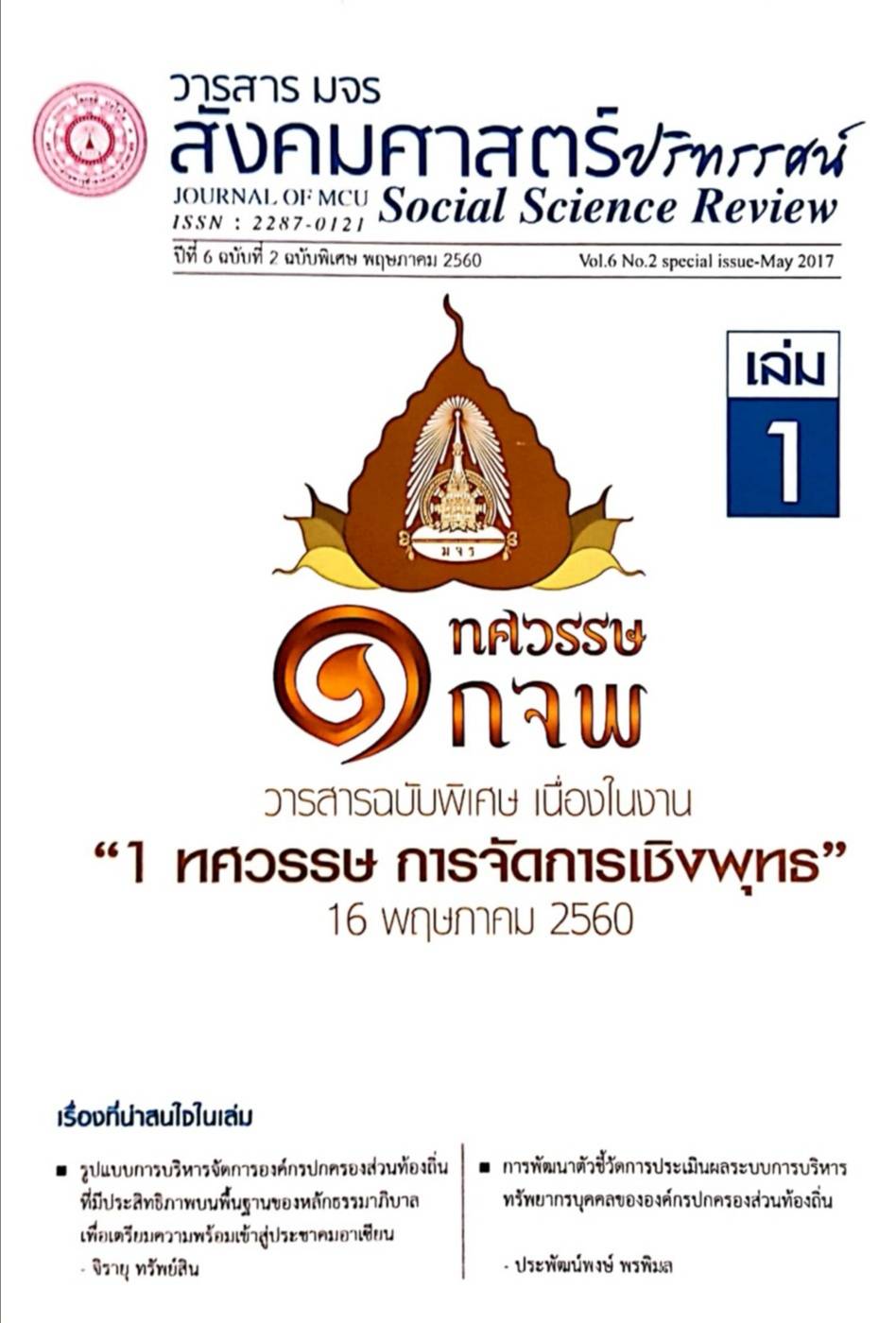รูปแบบธรรมราชาในสังคมไทย
คำสำคัญ:
ธรรมราชา, ธรรมราชาในสังคมไทย, รูปแบบธรรมราชาในสังคมไทยบทคัดย่อ
บทความวิจัยครั้งนี้มีวัตถุประสงค์ 3 ประการ คือ 1) เพื่อศึกษาธรรมราชาใน
พระพุทธศาสนาเถรวาท 2) เพื่อศึกษาวิเคราะห์ความเป็นธรรมราชาของพระมหากษัตริย์ใน
สังคมไทย และ 3) เพื่อนาเสนอรูปแบบธรรมราชาในสังคมไทย ระเบียบวิธีวิจัยเป็นการวิจัยเชิง
คุณภาพ (Qualitative Research) เชิงพุทธบูรณาการ โดยเน้นการศึกษาในเชิงเอกสาร ศึกษา
ค้นคว้ารวบรวมข้อมูลจากพระไตรปิฎก ตารา บทความวิชาการ และเอกสารงานวิจัยที่เกี่ยวข้อง
วิเคราะห์ข้อมูลด้วยวิธีการวิเคราะห์แบบอุปนัยและพรรณนาความ โดยใช้ทฤษฎีสังคมวิทยาเป็น
กรอบในการวิเคราะห์ 5 ทฤษฎี คือ 1. ทฤษฎีโครงสร้างหน้าที่ 2. ทฤษฎีการแลกเปลี่ยน
3. ทฤษฎีอรรถประโยชน์ 4. ทฤษฎีการขัดแย้ง และ 5. ทฤษฎีปรากฏการณ์นิยม
ผลการศึกษาวิจัยพบว่า แนวคิดเรื่องธรรมราชามีปรากฏในคัมภีร์พระพุทธศาสนาเถร
วาท แบ่งออกเป็นแนวคิดทางธรรม หมายถึง พระพุทธเจ้าทรงปกครองโดยธรรม และแนวคิดทาง
โลก หมายถึง ราชาหรือผู้นาที่ปกครองโดยใช้หลักธรรมในทางพระพุทธศาสนา ข้อที่สองพบว่าธรรม
ราชาในสังคมไทย มีพระเจ้าอโศกมหาราชทรงเป็นธรรมราชาต้นแบบทางโลก ที่มุ่งสร้างอัตตหิต
สมบัติและปรหิตปฏิบัติ คุณลักษณะธรรมราชาในสังคมไทย 4 ด้าน คือ 1. ด้านกายภาพ คือ
คุณสมบัติภายนอกที่เกิดขึ้นด้วยอานาจบุญ 2. ด้านพฤติภาพ คือภาวะอันส่งผลต่อพฤติกรรมที่
ประกอบด้วยพุทธภาวะ มีกรอบแห่งศีล 5 และกุศลกรรมบถ 10 เป็นพื้นฐาน 3. ด้านจิตภาพ คือ
ภาวะอันส่งผลต่อสภาวะจิตใจ เป็นแนวทางการพัฒนาทางด้านจิตใจตามหลักทศพิธราชธรรม
4 . ด้านปัญญาภาพ คือภาวะอันส่งผลต่อการที่จะเอาชนะหมู่สัตว์ทั่วแผ่นดินด้วยราชธรรมนั้น ซึ่ง
ผู้ปกครองจะต้องมีความเฉลียวฉลาดในการบริหารจัดการรัฐและครองแผ่นดินโดยธรรม เพื่อ
ประโยชน์สุขแห่งมหาชน ข้อที่สามพบว่ารูปแบบธรรมราชาในสังคมไทยประกอบ 3 ประการคือ 1) รูปแบบภาวะผู้นาตามแนวการจัดการเชิงพุทธ 2) รูปแบบการนาศาสตร์ต่างๆ มาประยุกต์ใช้ตาม
สถานการณ์ (ศาสตร์พระราชา) และ 3) รูปแบบการสื่อสารเชิงจิตวิทยามวลชนแนวพุทธ ใน
การศึกษาเรื่องรูปแบบธรรมราชาในสังคมไทยพบว่า พระบาทสมเด็จพระปรมินทรมหาภูมิพลอดุลย
เดชทรงเป็นพระมหากษัตริย์พระองค์เดียว ที่ทรงมีความเป็นธรรมราชาในสังคมไทยอย่างสมบูรณ์
แบบทั้งคุณลักษณะ 4 ด้าน
เอกสารอ้างอิง
เจ้าตากสิน). จุลศักราช 1128 ถึง 1144, 2472.
กรมศิลปากร. (2526). จารึกสมัยสุโขทัย กรมศิลปากรจัดพิมพ์เนื่องในโอกาสฉลอง 700 ปี ลายสือ
ไทยพุทธศักราช 2526. กรุงเทพฯ: กรมศิลปากร,
คณะวิศวกรรมศาสตร์ มหาวิทยาลัยเกษตรศาสตร์. (2551). พระบรมธรรมิกราช. กรุงเทพฯ:
สานักพิมพ์มหาวิทยาลัยเกษตรศาสตร์.
ชะม้อย คุมพล. (2553). การศึกษาวิเคราะห์เชิงพุทธจริยธรรมการบริหารราชการแผ่นดินในสมัย
รัชกาลที่ 1 ที่ปรากฏในไตรภูมิวินิจฉยกถา. วิทยานิพนธ์พุทธศาสตรมหาบัณฑิต. บัณฑิต
วิทยาลัย: มหาวิทยาลัยมหาจุฬาลงกรณราชวิทยาลัย.
ดร.สุทิติ ขัตติยะ, วิไลลักษณ์ สุวจิตตานนท์. (2554). แบบแผนการวิจัยและสถิติ. กรุงเทพฯ: บจ.
ประยูรวงศ์พริ้นท์ติ้ง.
นครินทร์ แก้วโชติรุ่ง. (2556). “รูปแบบและหลักการของการปกครองในพระไตรปิฎก”. สารนิพนธ์
พุทธศาสตรดุษฎีบัณฑิต. บัณฑิตวิทยาลัย: มหาวิทยาลัยมหาจุฬาลงกรณราชวิทยาลัย.
พระครูโสภณปริยัติสุธี (ศรีบรรดร ถิรธมฺโม). (2553) “การศึกษาวิเคราะห์แนวคิดธรรมราชาตาม
หลักธรรมทางพระพุทธศาสนา”. รายงานวิจัย. ทุนอุดหนุนการวิจัยจากมหาวิทยาลัย
มหาจุฬาลงกรณราชวิทยาลัย, MCU RS 610654033.
พระพรหมคุณาภรณ์ (ป.อ.ปยุตฺโต) (2558).พจนานุกรมพุทธศาสน์ ฉบับประมวลศัพท์ (ชาระ-
เพิ่มเติม ช่วงที่ 1/ยุติ), พิมพ์ครั้งที่ 23, กรุงเทพฯ: สานักพิมพ์ผลิธัมม์ ในเครือบริษัท
สานักพิมพ์เพ็ทแอนด์โฮม จากัด.
มนูญ มุกข์ประดิษฐ์. (2547). “การศึกษาวิเคราะห์ปรัชญาเศรษฐกิจพอเพียงอันเนื่องมาจาก
พระราชดาริกับหลักธรรมในพระพุทธศาสนา”. วิทยานิพนธ์พุทธศาสตรดุษฎีบัณฑิต.
บัณฑิตวิทยาลัย: มหาวิทยาลัยมหาจุฬาลงกรณราชวิทยาลัย.
มหาจุฬาลงกรณราชวิทยาลัย. (2535). พระไตรปิฎกภาษาบาลี. ฉบับมหาจุฬาเตปิฏก . 2500.
กรุงเทพฯ: มหาจุฬาลงกรณราชวิทยาลัย.
สุเทพ พรมเลิศ. (2553). “ศึกษาวิเคราะห์สังคมการเมืองในจักกวัตติสูตร”. สารนิพนธ์พุทธศาสตร
ดุษฎีบัณฑิต. บัณฑิตวิทยาลัย: มหาวิทยาลัยมหาจุฬาลงกรณราชวิทยาลัย.
อานวย วีรวรรณ. (2555). “พระมหากษัตริย์ไทยกับพระพุทธศาสนา” กรุงเทพฯ: บริษัทอมรินทร์พ
ริ้นติ้งแอนด์พับลิซซิ่งจากัด.
Bertil Lintner. Blood Brothers: The Criminal Underworld of Asia. Macmillan
Publishers. ISBN 1403961549.
Blumer, Herbert (1966). Sociological Implications of the Thought of George Herbert
Mead. American Journal of Sociology. 71 (5) March 1966.
Chris Baker. Pasuk Phongpaichit. A History of Thailand. Cambridge University Press.
ISBN 0521816157.
Glaser, B. and Strauss, A. (1967). The Discovery of Grounded Theory, Hawthorne NY:
Aldine.
ดาวน์โหลด
เผยแพร่แล้ว
รูปแบบการอ้างอิง
ฉบับ
ประเภทบทความ
สัญญาอนุญาต
ลิขสิทธิ์ (c) 2020 วารสาร มจร สังคมศาสตร์ปริทรรศน์

อนุญาตภายใต้เงื่อนไข Creative Commons Attribution-NonCommercial-NoDerivatives 4.0 International License.
เพื่อให้เป็นไปตามกฎหมายลิขสิทธิ์ ผู้นิพนธ์ทุกท่านต้องลงลายมือชื่อในแบบฟอร์มใบมอบลิขสิทธิ์บทความให้แก่วารสารฯ พร้อมกับบทความต้นฉบับที่ได้แก้ไขครั้งสุดท้าย นอกจากนี้ ผู้นิพนธ์ทุกท่านต้องยืนยันว่าบทความต้นฉบับที่ส่งมาตีพิมพ์นั้น ได้ส่งมาตีพิมพ์เฉพาะในวารสาร มจร สังคมศาสตร์ปริทรรศน์ เพียงแห่งเดียวเท่านั้น หากมีการใช้ภาพหรือตารางหรือเนื้อหาอื่นๆ ของผู้นิพนธ์อื่นที่ปรากฏในสิ่งตีพิมพ์อื่นมาแล้ว ผู้นิพนธ์ต้องขออนุญาตเจ้าของลิขสิทธิ์ก่อน พร้อมทั้งแสดงหนังสือที่ได้รับการยินยอมต่อบรรณาธิการ ก่อนที่บทความจะได้รับการตีพิมพ์ หากไม่เป็นไปตามข้อกำหนดเบื้องต้น ทางวารสารจะถอดบทความของท่านออกโดยไม่มีข้อยกเว้นใดๆ ทั้งสิ้น





